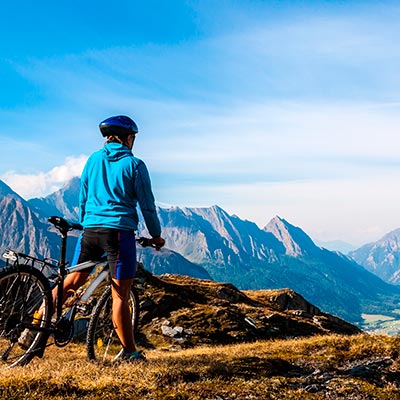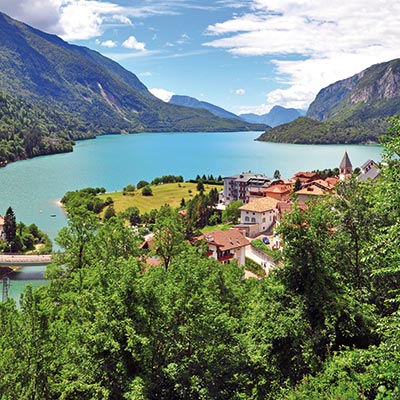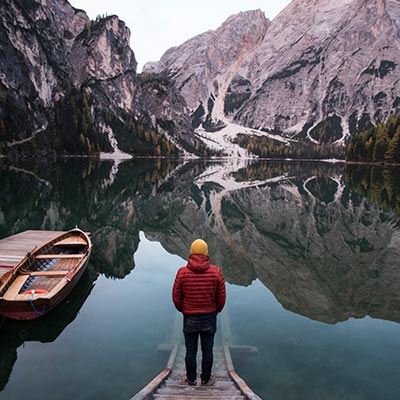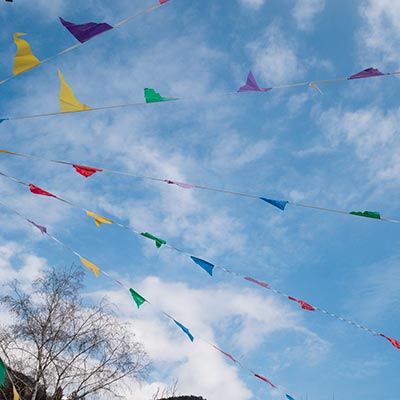Get alpine and uncover Italy's gorgeous Dolomite region with our travel guide
Nestled within the Southern Limestone Alps, the Italian Dolomites mountain range has all the right ingredients for an idyllic alpine getaway. There’s the jagged peaks, for a start. Then there’s the turquoise rivers which flow through the valleys here, paired with the fragrant, fresh mountain air.
To get the most out of this UNESCO-listed area, use Saga's Dolomites guide and familiarise yourself with this region of Italy before you've even left your front door.
Live and breathe the magic of the Dolomites
Whether you’re wondering where to find the most authentic Italian cuisine, which mountainside walk offers the best viewpoints or what historic and cultural sites to visit, we're on hand to ensure your holiday here is everything you want it to be.
Uncover the best pizzerias, the most serene peaks or castles which’ll take you back centuries. Take advantage of our expert knowledge – both in terms of attractions and general day-to-day living in the Dolomites.
You’ve got a few options for getting around the Dolomites, with buses and taxis linking you to nearby towns, cities and beyond.
Travelling by bus in the Dolomites
The number 611 bus can take you northeast from Molveno to the neighbouring Andalo village. The journey is around seven minutes and costs a little over €2. Services run throughout the day, although be wary of variations on Sundays and public holidays. If you’re in any doubt over timetables, visit the Trentino Transport website.
South of Molveno, you can get the number 208 bus to San Lorenzo Dorsino. It’ll take around 25 minutes each way, while tickets cost roughly €2. Buses here can be infrequent, so again, it’s advisable to check online or ask hotel staff for advice before travelling anywhere.
To get to Cavedago, get the number 611 bus north of Molveno and past Andalo. The journey will take 20 minutes, again costing around €2. Services run from morning through to the evening, although they’re less frequent on Sundays and public holidays. Make sure you check when the last bus back to Molveno is, unless you’re planning to get a taxi back.
Travelling by train in the Dolomites
Trains run from Mezzolombardo, which is a half-hour drive from Molveno. From there, you can then get services to popular destinations like Trento for around €3 and Dimaro for around €5. Routes also run to renowned Italian cities such as Venice and Verona, although these are more expensive with much longer journey times.
Travelling by car in the Dolomites
You can also rent a car from Cavedago. Saga customers are entitled to preferential rates from Hertz – we recommend booking in advance to be safe. Just be sure to bring the relevant documentation and you’ll be driving around the stunning Dolomite roads in next to no time.
Travelling by taxi in the Dolomites
It is possible to travel by taxi, although this is a little more expensive, costing roughly €9 for a six-mile journey. Ask a member of staff at reception for assistance – they’ll be happy to order you one.
Bike rental in the Dolomites
Bicycle hire service Dolomiti Paganella Bike operates within Molveno, with a wide selection of bikes to cater for everyone from mountain bikers to casual cyclists.
Useful transport links
Use the following links to learn more about how to explore the Dolomites. Some websites are in Italian, but your web browser may offer to translate this for you.
Buses: Trentino Transport
Trains: virail
Bikes: Dolomiti Paganella Bike
Please note that all prices are accurate at time of publishing.
The beauty of the Dolomites runs through both its natural, alpine allures and historic, man-made sites. Here’s a few must-dos…
Molveno – historic sites
Not to be confused with the Swiss attraction of a similar name, Castel Thun is one of the last remaining castles in Italy’s Trentino province. It’s a few miles from Molveno and has been open to the public since 2010.
Once you’ve walked past the various fortifications, you’ll enter a courtyard, where you can get a chance to explore rooms and corridors dating back to the 16th century.
Molveno – natural beauty
Lake Molveno’s green and blue shades seamlessly blend into the verdant mountains which surround its shores. It’s the deepest lake in the Trentino province, stretching some 4.5 kilometres in length through the Dolomites.
Visit here and lose yourself to the tranquil surroundings of Molveno. To see the area from a higher perspective, take the Molveno–Pradel cable car and gaze upon the lake and now-tiny buildings from afar.
Molveno – scenic walks
From the Alle Dolomiti hotel, you can drive to the Rifugio La Montanara mountain refuge. Start by climbing up to the viewpoint, where there are ample photo opportunities of the surrounding countryside.
You can take a balcony walk back down, before ascending again to the Rifugio Croz dell'Altissimo. It gets a little steeper here, but the walk goes on to finish on a relatively stable gradient.
Molveno – religious buildings
Central Molveno is home to the beautiful 13th-century Church of San Vigilio. It features a moon-shaped painting of Jesus, the Virgin Mary and St John on the outside, while inside there’s a mural painting of the Last Supper.
The church may be small but it’s special nonetheless, standing as a poignant memory to Saint Vigilius, one of Trento’s former bishops, who is said to have been martyred around 400 BC.
Trentino – natural beauty
The artificial Emerald Lake is within driving distance from the castle. It’s near Tirol, a commune close to the city of Bolzano. This calming man-made spectacle is a popular spot for canoeing, while the wooden hut on the shores is picture-perfect, no matter what angle you look at it from.
Aside from the serene scenery on your doorstep, Trentino and the Dolomites are filled with verdant natural wonders which’ll really knock you for six.The Parco Naturale Adamello Brenta is a nature reserve, just a couple of hours’ drive from Molveno.
Explore its lakes and forests, or marvel at any of the 41 glaciers within the park’s territory. Highlights include the Nardis Waterfall - here, jets of water dramatically plummet 130 metres from their summit.
Lake Garda – natural beauty
You’ll need to put a day aside for this, but the experience of seeing Italy’s largest, and arguably most popular, lake makes it more than worth it. Go to the lakeside town of Riva del Garda, situated at the northern side of Lake Garda.
Boat trips will take you to other renowned nearby destinations, or you could always just enjoy the refreshing lake breeze while taking in the scenery.
Trento – architecture
The university city of Trento is 43 kilometres’ drive from Molveno. It’s a good chance to see a more cosmopolitan side to Italy and look out over the Renaissance architecture which embodies much of the city centre.
Above all that, though, there’s the impressive Castello del Buonconsiglio, a castle and palace which housed some of Trento’s religious elite for hundreds of years. It is now a museum with a Provincial Gallery of Art, too.
Bolzano – museums
Bolzano’s South Tyrol Museum of Archaeology is an hour and 45 minutes’ drive from Molveno. There’s a permanent exhibition dedicated to the mummified Otzi the Iceman, who is said to have lived sometime between 3400 and 3100 BCE.
It takes up three floors of the museum, displaying everything there is to know about the world’s most renowned glacial mummy. Other permanent and non-permanent exhibitions also run, and give visitors an insight into how our ancestors lived.
Andalo – scenic walks
Walking between the communes of Andalo to Spormaggiore is a sure-fire way to soak up some of the Dolomites’ best scenery. Starting from the seasonal Lake Andalo, which disappears and reappears based on rainfall, make your way through woodland towards a fast-flowing river.
Follow it downhill, through quaint orchards, before you reach the town of Spormaggiore. The walk covers 12 kilometres and is suitable for most abilities.
Food
As you’d expect, cuisine in the Dolomites is highly revered. A typical main course would be polenta served up with some venison, with cheese melted over it.
Cheese originating from the Italian town of Belluno is then sprinkled over the dish. Starters consist of cured meat, whereas a typical dessert would be ice cream or tiramisu.
Wine
Italian wine is renowned worldwide and some of its finest blends come from the Dolomites region. They’re fresh, complex and acidic in taste, and white varieties made with the Nosiola grape are found in a lot of local bars and restaurants.
Popular reds are usually made from the Vespolina and Croatina grapes, which are grown in Piedmont and Lombardy.
Beer and spirits
While the Dolomites isn’t exactly known for its beer, you’ll still come across a fair few renowned brands on tap. Munich beers such as Weihenstephaner and Augustiner are popular here and make for a refreshing way to see in the sunset.
Otherwise, keep your eyes peeled for well-known Italian beers like Birra Moretti and Peroni, and grappa, the distilled and aged grape spirit and digestif, which is unique to Italy.
While fairly cold in the winter, the Dolomite region of Italy is perfect for a warm and sunny summer holiday.
Visiting the Dolomites in the summer
Compared to roasting hot Italian cities like Milan, summertime in the Dolomites tends to be fairly mild, with highs reaching 25 degrees Celsius and averages of 20 degrees Celsius. Rainfall can be quite common between July and August, so pack a waterproof which’ll keep you dry on wet days. Bring light garments that you’d feel comfortable walking in – hiking boots and an anorak are a must, regardless of the season.
Visiting the Dolomites in the spring or autumn
It might be a little cooler during spring and autumn, but weather conditions here usually remain stable enough to get out and enjoy the great outdoors.
A little snow might still be present come the start of spring, too, painting the Dolomites in pretty blends of green and white. Highs for these seasons range between 15 and 20 degrees Celsius – pack a mixture of warm and light clothing, depending on how high you’re going to be.
Visiting the Dolomites in the winter
Temperatures really drop come winter, often dipping below freezing. Snowfall tends to start around December, continuing to late March.
There isn’t too much rainfall, but it’s best to pack waterproof clothes anyway to help you stay dry in the snow. Pack woollen gloves, hats and hiking trousers if you plan on going on any longer treks.
There’s plenty of events here to keep you busy throughout the year, celebrating everything from cuisine to ancient, pagan traditions.
Carnival in the Dolomites (February)
The acclaimed Carnival in the Dolomites is celebrated every February. Nearly every valley in the Dolomites has its own carnival traditions, but a good example of a typical celebration would be the Ladin Carnival, which takes place in the villages of Alba, Penia and Campitello di Fassa.
People dress up as folklore characters which derive from the area, donning wooden masks and taking to the streets in procession.
Contrastingly, many other towns prefer to mark the Carnival in the Dolomites with colourful floats and other eclectic outfits. In Bolzano, locals go all-out with an Egetmann procession, a trumpet-led parade in which residents dress up as farmers and other labourers.
Ciuiga Festival – San Lorenzo (November)
This festival takes place annually in San Lorenzo, at the foot of the Dolomites, to celebrate the ciuiga sausage, a delicacy produced locally and made of pork and turnips.
Each year, the streets fill up with exhibitions, food stalls and small stages for music performances.
Sounds of the Dolomites (July – August)
Acclaimed worldwide, the Sounds of the Dolomites festival is perhaps one of the most picturesque musical events out there. Musicians from all around gather to perform in an alpine setting, with clearings and mountain refuges becoming performance areas.
The festival usually centres around the Dolomites’ sunrise show, when musical renditions soundtrack the sun’s ascent into the sky – what better way to start your day?






